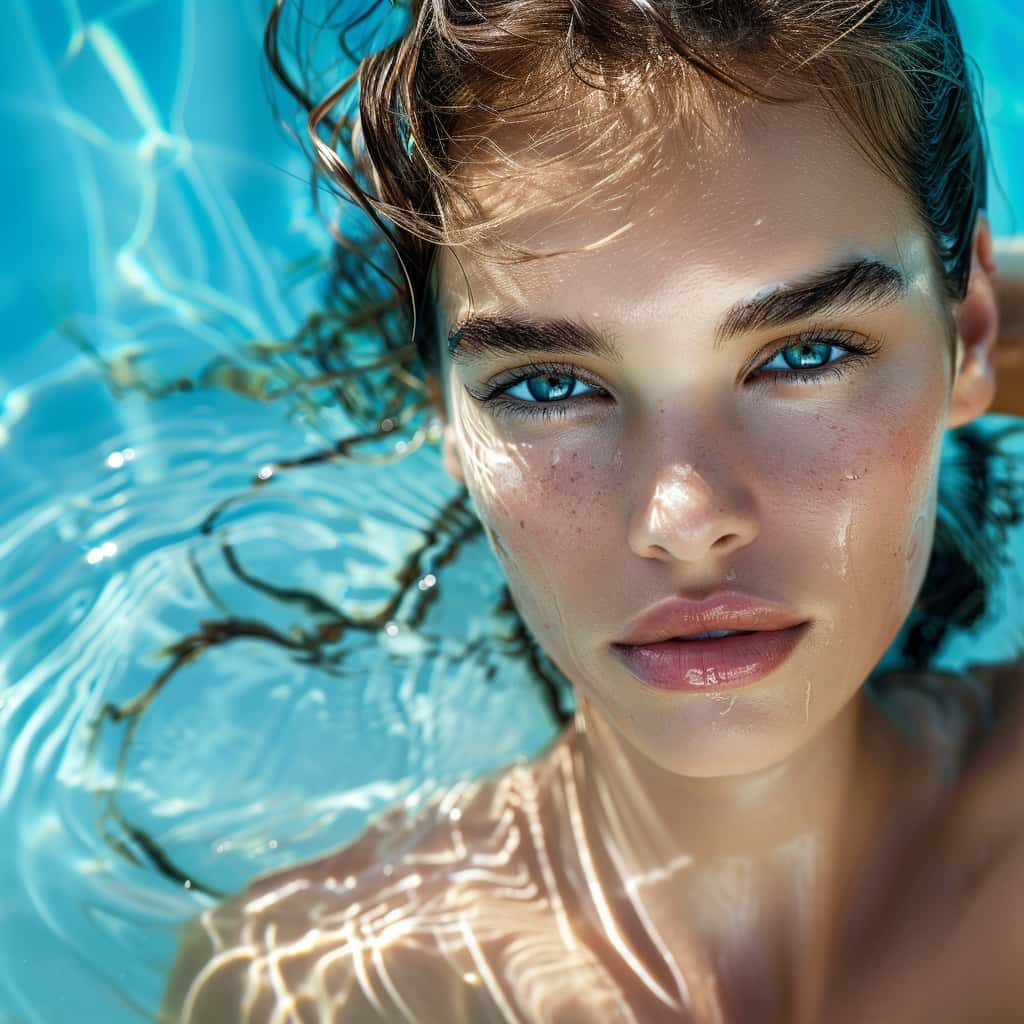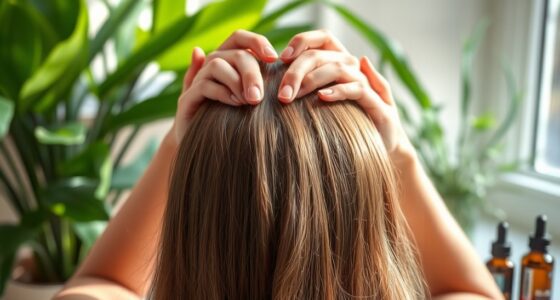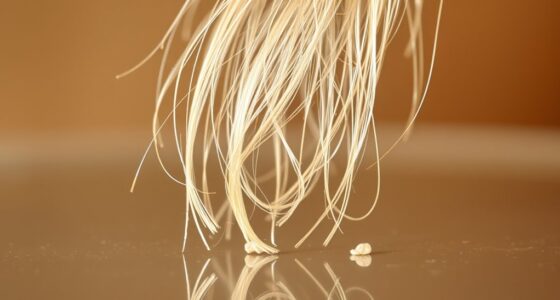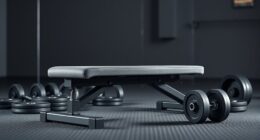Aleave-in conditioner helps boost your hair’s moisture, protection, and manageability by applying it to damp hair without rinsing. It nourishes strands, supports scalp health, and can make your hair look thicker and fuller over time. Use it after towel-drying, focusing on mid-lengths and ends, and distribute evenly. Consistent use keeps your hair resilient and vibrant. Want to discover tips for maximizing its benefits? Keep exploring to learn more.
Key Takeaways
- Leaves hair moisturized, protected, and manageable without rinsing out, enhancing overall hair health.
- Supports scalp health and hair growth by nourishing strands and preventing damage.
- Helps improve hair thickness, volume, and resilience over time with regular use.
- Apply to damp hair, focusing on mid-lengths and ends, using a small amount to avoid buildup.
- Incorporate into daily routines for consistent benefits and healthier, more vibrant hair.
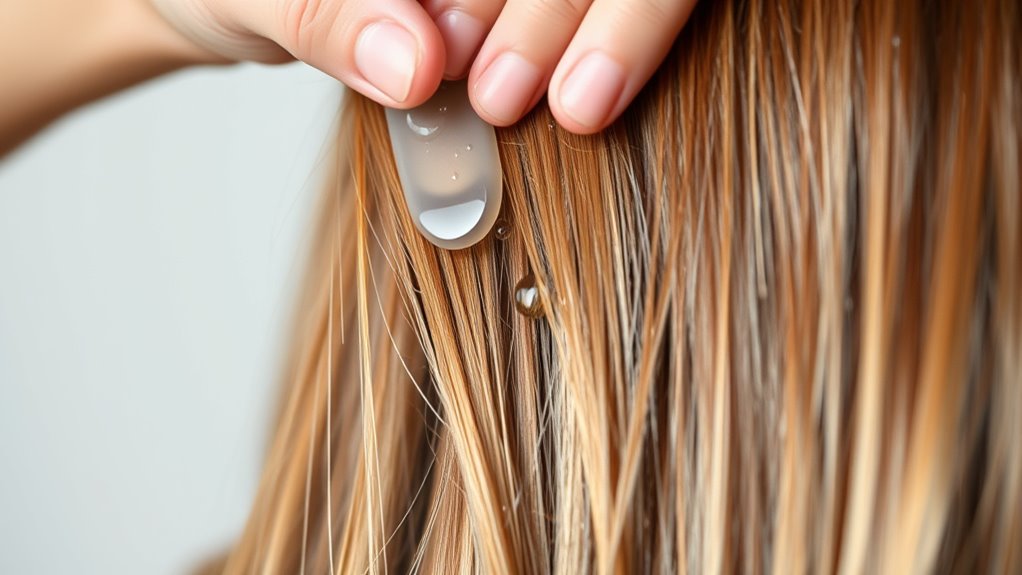
A leave-in conditioner is a lightweight hair treatment designed to be applied after washing and left in without rinsing out. It’s a versatile product that can transform your hair routine by providing ongoing moisture, protection, and manageability. When you use a leave-in conditioner regularly, you may notice improvements in your hair’s overall appearance, especially if you’re aiming to boost hair density or improve scalp health. These benefits come from the way leave-in conditioners nourish your strands and support a healthy scalp environment.
One of the key advantages of using a leave-in conditioner is that it helps to prevent breakage and split ends, which can hinder hair growth and make your hair look thin or damaged. When your hair is well-moisturized and protected from environmental stressors, it tends to appear thicker and fuller. This can give the impression of increased hair density over time. Additionally, many leave-in formulas contain ingredients like biotin, keratin, or botanical extracts that strengthen hair strands, helping to support the appearance of more voluminous hair. The right product can also address scalp health by soothing irritation, reducing dryness, and balancing oil production, which in turn encourages healthier hair growth.
Using leave-in conditioner helps prevent damage, making hair look thicker and more voluminous over time.
Using a leave-in conditioner correctly is essential to maximize its benefits. After washing your hair, towel-dry to remove excess water, then apply a small amount of product evenly through your damp hair, focusing on the mid-lengths and ends. Avoid applying too much near your roots unless the product specifically targets scalp health, as excess product can weigh hair down or cause buildup. Comb through your hair to distribute the conditioner thoroughly, which helps to detangle and prevent breakage during styling. You’ll want to choose a formula that suits your hair type—whether it’s curly, fine, or thick—to ensure ideal results.
Incorporating a leave-in conditioner into your daily routine can markedly improve your hair’s resilience and appearance. Regular use can help maintain scalp health by providing essential nutrients and moisture, which are critical for hair density. When your scalp is healthy, hair growth tends to be more robust, and your hair looks fuller and more vibrant. Keep in mind that scalp health plays a crucial role in overall hair quality and density. Remember that consistency is key; the more you care for your scalp and strands with the right products, the better your chances of achieving thicker, healthier hair. A leave-in conditioner is a simple yet powerful tool to support your hair goals, making your routine easier while delivering noticeable improvements.
Frequently Asked Questions
Can Leave-In Conditioner Be Used Daily Without Buildup?
Yes, you can use leave-in conditioner daily without buildup if you choose a lightweight formula and apply it properly. Focus on product layering, applying mainly to the mid-lengths and ends, avoiding the scalp to maintain scalp health. Regularly clarify your hair to remove excess product, and monitor how your hair responds. This helps prevent buildup and keeps your hair soft, manageable, and healthy without weighing it down.
Is Leave-In Conditioner Suitable for All Hair Types?
Think of your hair as a garden needing tailored care. Leave-in conditioner suits all hair types, but you should consider your hair porosity and scalp sensitivity. Fine or high-porosity hair might need a lighter formula, while thicker or low-porosity hair benefits from richer conditioners. If your scalp is sensitive, opt for gentle, hypoallergenic options. Adjust the product to your unique needs, nurturing your hair’s health like tending to a delicate bloom.
How Do I Choose the Right Leave-In Conditioner?
To select the appropriate leave-in conditioner, consider your hair porosity and ingredient sensitivity. If your hair has high porosity, look for lightweight formulas that hydrate without weigh-down. For low porosity hair, opt for rich, penetrating ingredients. If you’re sensitive to certain ingredients, read labels carefully and choose products free from potential irritants. Test new products on a small section first to make sure they suit your hair needs.
Can Leave-In Conditioner Replace Regular Rinsing Shampoos?
No, leave-in conditioner can’t replace regular rinsing shampoos. While it nourishes and detangles, it doesn’t cleanse your hair or scalp, which is essential for scalp health and removing buildup. Rinsing shampoos are formulated to deeply cleanse, preventing issues like dandruff and excess oil. Use leave-in conditioner after washing to maintain moisture and manageability, but don’t skip your regular shampoo routine for ideal hair cleansing and scalp health.
Are There Any Ingredients to Avoid in Leave-In Conditioners?
You should avoid leave-in conditioners with harmful chemicals like sulfates, parabens, and alcohols, which can damage your hair or irritate your skin. Also, steer clear of products with allergic ingredients such as fragrances and dyes, especially if you have sensitive skin. Always check the ingredient list and opt for formulas with natural, nourishing components to keep your hair healthy and avoid unwanted reactions.
Conclusion
Remember, a good hair care routine is like planting a seed—you need patience and consistency to see the best results. Using a leave-in conditioner correctly keeps your hair moisturized, manageable, and healthy. Don’t forget, the key to beautiful hair is loving and caring for it every day. As the saying goes, “You reap what you sow.” So, keep nourishing your hair, and it’ll reward you with shine and strength.
Claire has a knack for turning complex dermatological concepts into engaging, easy-to-understand articles. Her work primarily focuses on creating detailed reviews and thought-provoking articles in the “Vetted” category. Claire’s writing not only informs but also inspires our community to try new skincare solutions.


